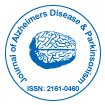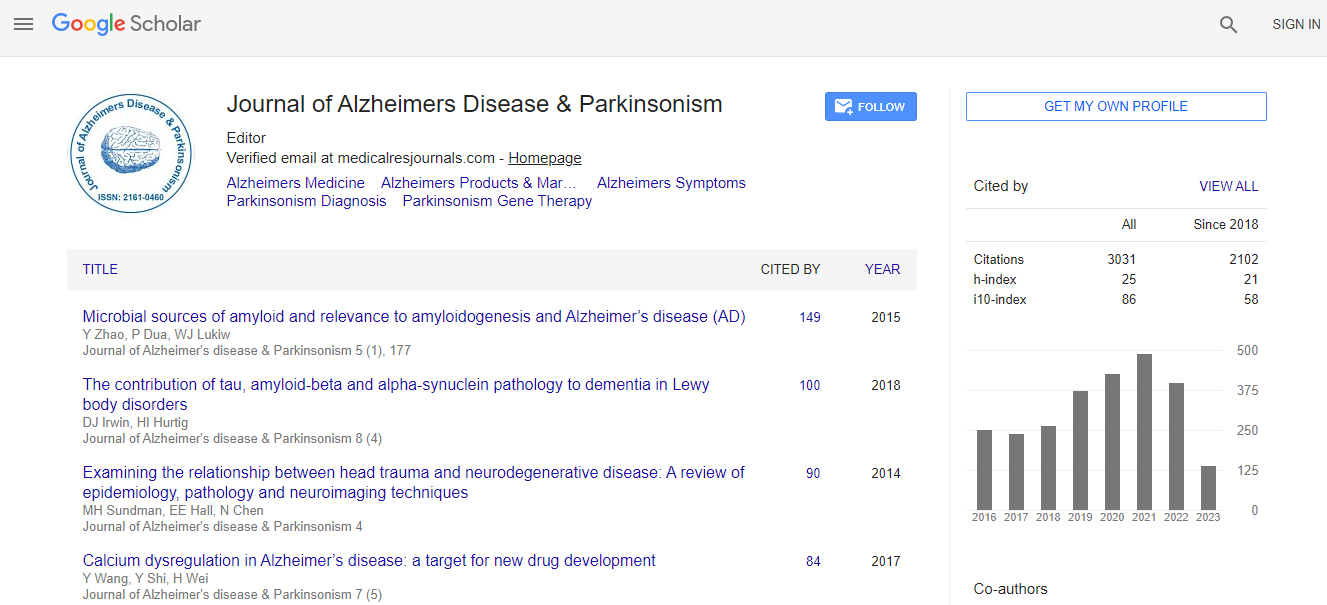Our Group organises 3000+ Global Conferenceseries Events every year across USA, Europe & Asia with support from 1000 more scientific Societies and Publishes 700+ Open Access Journals which contains over 50000 eminent personalities, reputed scientists as editorial board members.
Open Access Journals gaining more Readers and Citations
700 Journals and 15,000,000 Readers Each Journal is getting 25,000+ Readers
Google Scholar citation report
Citations : 4334
Journal of Alzheimers Disease & Parkinsonism received 4334 citations as per Google Scholar report
Journal of Alzheimers Disease & Parkinsonism peer review process verified at publons
Indexed In
- Index Copernicus
- Google Scholar
- Sherpa Romeo
- Open J Gate
- Genamics JournalSeek
- Academic Keys
- JournalTOCs
- China National Knowledge Infrastructure (CNKI)
- Electronic Journals Library
- RefSeek
- Hamdard University
- EBSCO A-Z
- OCLC- WorldCat
- SWB online catalog
- Virtual Library of Biology (vifabio)
- Publons
- Geneva Foundation for Medical Education and Research
- Euro Pub
- ICMJE
Useful Links
Recommended Journals
Related Subjects
Share This Page
Peripheral protein aggregates as biomarkers for neurodegenerative diseases
11th International Conference on Vascular Dementia
Shu G Chen
Case Western Reserve University School of Medicine, USA
Keynote: J Alzheimers Dis Parkinsonism
Abstract
Neurodegenerative diseases such as Parkinson’s disease (PD) and Alzheimer’s disease (AD) are characterized by the deposition of misfolded protein aggregates in the central nervous system (CNS). Previous efforts have focused on the development of CNS-proximal clinical biomarkers, including PET neuroimaging and cerebrospinal fluid measures of alpha-synuclein, beta-amyloid and tau. However, these diagnostic techniques are often used in clinical studies on patients with advanced disease state, and are complex, invasive or expensive. Therefore, there remains an urgent need for reliable, inexpensive and minimally invasive peripheral biomarkers. Recent studies have revealed widespread peripheral involvement of PD- and AD-like pathology, often prior to clinical manifestations of the diseases. Indeed, alpha-synuclein and tau deposits have been observed in peripheral tissues in PD and AD, respectively. A formidable challenge is that the levels of these amyloidogenic protein aggregates in peripheral tissues are extremely low and thus only variably detectable using immunological methods. Therefore, highly sensitive analytical platforms are required as the new generation of biomarker assays specific for protein aggregates and amyloid fibrils. The real-time quaking induced conversion (RT-QuIC) has emerged as a robust, rapid and ultrasensitive technology for template-assisted amplification of misfolded protein aggregates in neurodegenerative diseases. Using the RT-QuIC technique, our recent studies have shown that disease-associated protein aggregates are readily detectable in peripheral tissues of patients affected by PD, dementia with Lewy bodies, and AD and other tauopathies. Validation of peripheral protein biomarkers will enable sensitive premortem diagnostic tests for PD, AD, and related disorders, and accelerate clinical trials for disease-modifying therapies.Biography
Shu G Chen has received his PhD in 1992 from the State University of New York at Buffalo, New York, USA. He is an Associate Professor of Pathology and Neurology at Case Western Reserve University School of Medicine. His research centers on pathogenesis of Parkinson’s disease, Alzheimer’s disease and other neurodegenerative disorders. He has published more than 80 papers in scientific journals.
E-mail: sxc59@case.edu

 Spanish
Spanish  Chinese
Chinese  Russian
Russian  German
German  French
French  Japanese
Japanese  Portuguese
Portuguese  Hindi
Hindi 
